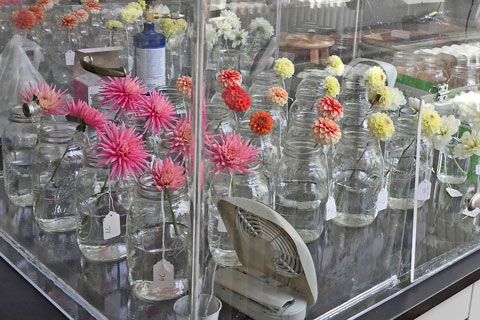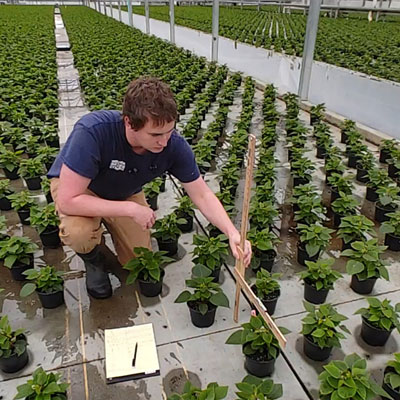7/1/2022
Reap the Rewards of Research
Julie Martens Forney

Imagine having a partner that provides industry-focused research that addresses problems you face every day, like rising production costs, pesticide resistance and labor issues. You could access the research results—for free—at any time, day or night, and these results would help you manage costs while producing strong and healthy plants. That’s just a sampling of what the American Floral Endowment (AFE) does for you.
When you discover the real-world impacts of research, it changes how you grow crops. Aaron Bivens is Western Division Head Grower at Altman Plants in Colorado. He’s a fan of using DIF on Altman’s poinsettia crops—hundreds of thousands of them. DIF describes how plant growth responds to temperature. It’s short for “difference between day and night temperatures.” These days, it’s standard industry practice. Over 30 years ago, it was a research project funded by the Endowment.
Aaron uses AFE-funded DIF research as his “first tool for poinsettias. I like the results it gives—ultimately, plants that ship better and have a better shelf life,” he said.
He’s found that the trick to DIF is simple. “You gather the data and apply the data,” he says. “If you’re not analyzing the data, it’s a waste of time.”
That’s the entire point of research that AFE has funded for the past 61 years: gathering, analyzing and applying data. That kind of research approach delivers real-world impacts for the industry.
DIF research, which was first funded over 35 years ago, brings bottom-line effects—it’s a true cost-saving measure. Growers who use DIF apply fewer growth regulators, saving money on chemicals, as well as the labor needed to apply those chemicals. Growers who practice morning temperature drop as part of their DIF program see additional cost savings in heat usage.
 Pictured: When AFE funds postharvest research, the result is longer-lasting flowers and plants, which means happier customers and better profits at every level of the industry.
Pictured: When AFE funds postharvest research, the result is longer-lasting flowers and plants, which means happier customers and better profits at every level of the industry.
Reducing water use
Just as water is foundational to greenhouse crop production, conserving this precious resource is equally fundamental to life in the 21st Century. Whether it’s ever-tightening water restrictions in drought-plagued Los Angeles County or newly imposed limits placed on Central Arizona farmers and ranchers, water use and availability is a current hot-button topic that’s not going away. No matter where you’re located, if you’re growing crops, you need to manage water more efficiently than ever to compete in the current market.
AFE-funded research done at Texas A&M University shows that you can grow bedding plants that are compact with darker green leaves, increased flower numbers and more roots by allowing plants to wilt prior to watering. Instead of keeping soil constantly moist, you can withhold water just to the point of wilting (roughly a 20% dry-down of soil) and produce healthy crops that look great and have a strong shelf life.
This research study also delivers a host of indirect benefits to growers who put the results into practice. Watering plants less frequently reduces overall water and labor costs. It also reduces fertilizer costs since most watering is fertigation. More compact plants mean you can fit more plants per square foot of production space, which yields an immediate impact on margins.
Winning against pests
The secret to success in the ever-raging war against pests and diseases is having a fully integrated program that incorporates literally everything at your disposal, including traditional pesticide sprays, biocontrols, fertilizer inputs, pre-plant dips and guardian plants. AFE-funded research is laser-focused on developing new methods of dealing with pests and diseases, methods that look to expand the arsenal of treatments beyond traditional weapons.
Here are some of the latest answers from AFE-funded research to help you beat pests and diseases:
• Botrytis and calcium. Botrytis has developed resistance to many available fungicides, so a sustainable solution must be found. AFE has teamed up with researchers at Clemson University to find an environmentally friendly answer that won’t produce further disease resistance.
The answer? Calcium sprays help reduce Botrytis. This method works on poinsettia and geranium stock plants, yielding tougher, toned cuttings better able to withstand the physical stresses of the postharvest shipping environment.
Calcium sprays also reduce Botrytis on petunia flowers. Comparing petunias sprayed with a fungicide (containing both cyprodinil and fludioxonil) to ones sprayed with calcium chloride, researchers found that petunias sprayed with calcium had significantly less Botrytis than the fungicide-treated ones. If you’re tired of dealing with petunia meltdown in shipping, calcium sprays could be the solution you need. Use weekly sprays at rates of 750 to 1,000 ppm during flower bud development.
• Thrips control. University of Vermont researchers have developed a system of using marigolds as guardian plants to help with controlling Western flower thrips using predatory mites. The guardian plant attracts thrips, acting as an indicator plant for a crop. When predatory mites are released, the marigold also provides a food source for the mites, which feed on thrips and pollen from the marigold flowers. The research also included releasing entomopathogenic fungi to the soil—a fungus that kills thrips when they pupate in soil. The entire system is sustainable, living and easy to set up, monitor and maintain.
• Whiteflies and thrips on poinsettias. The answer to this pest lies in an integrated approach that starts with pre-plant cutting dips, shifts to biocontrols and ends with pesticides late in the crop. The three-part recipe comes from Ontario’s Vineland Research & Innovation Centre. AFE helped fund the unrooted cutting dip study, which focuses on dipping cuttings in insecticidal soap, oil and/or biopesticides upon receipt. Dips kill any thrips or whitefly nymphs and pupae present on cuttings and leave minimal residue. This paves the way for biocontrol use once cuttings are stuck.

Care & handling
Another main focus of AFE-funded research has been producing quality crops that perform beyond the bench, surviving the stresses of shipping and standing up to retail conditions. Thanks to Endowment funding, research teams at the University of Florida developed production and shipping guidelines for many crops, including cut flowers, potted plants and bedding plants. Recent work has focused on the impact of ethylene on petunia flower meltdown in shipping.
Loading carts of petunias in flower onto trucks often results in flats of Botrytis-laced blooms upon receipt. The typical culprits for the fungal development include high humidity and mechanical damage or vibration during transport, which likely contribute to the outbreak. But research has found that petunia blooms produce ethylene when stressed, so the real source of the Botrytis outbreak are those open flowers.
Pictured: Using DIF principles to control poinsettia plant height lets you bring crops in on time at the right size with fewer growth regulator applications.
It’s a complex problem, but the solution is simple: Prevent Botrytis damage by treating plants with anti-ethylene products—EthlyBloc and Ethylene Buster—as soon as plants are loaded on trucks. Ethylene scrubbers won’t work on this problem—they can’t touch the ethylene produced inside the blooms.
The results of all AFE-funded research are freely available on the website (endowment.org). Free monthly Grow-Pro Webinars present the latest information available to fine-tune your crop production skills and include live Q&A sessions. Upcoming webinar topics include:
• “Using DIF and Graphical Tracking (to Bring Your Poinsettias in on Target),” presented by Dr. Royal Heins (August 23)
• “New Technology and Pesticides for Flower Crops,” presented by Dr. JC Chong (September 27)
• “Finishing Your Poinsettia Crop Successfully,” presented by Dr. Chris Currey (October 18)
For a full list of upcoming webinars, visit endowment.org/webinars. You can also contribute with a donation (tax deductible) or share an idea for a research project. GT
Julie Martens Forney is a freelance writer with more than 25 years of experience writing about floriculture industry issues and gardening for consumers. To read her current bylines, check out SAF’s Floral Management, HGTV.com and DIYNetwork.com. Julie’s also an avid gardener, tending edibles and perennials in a wildlife-friendly garden that features year-round color.